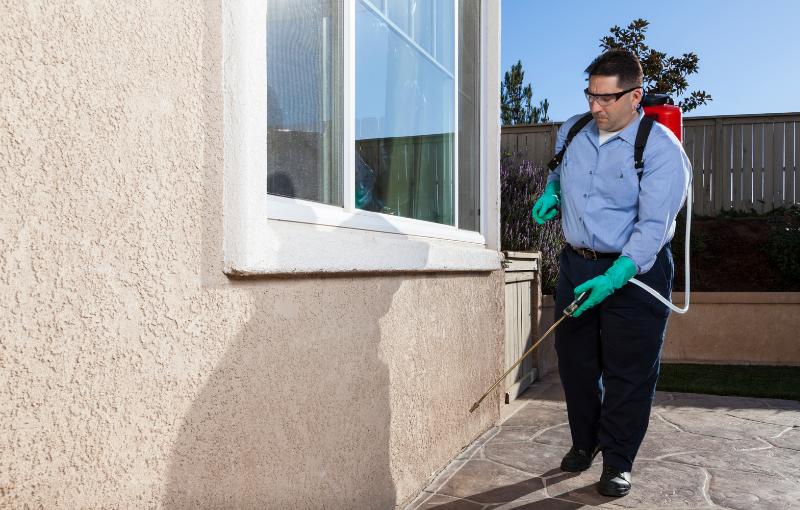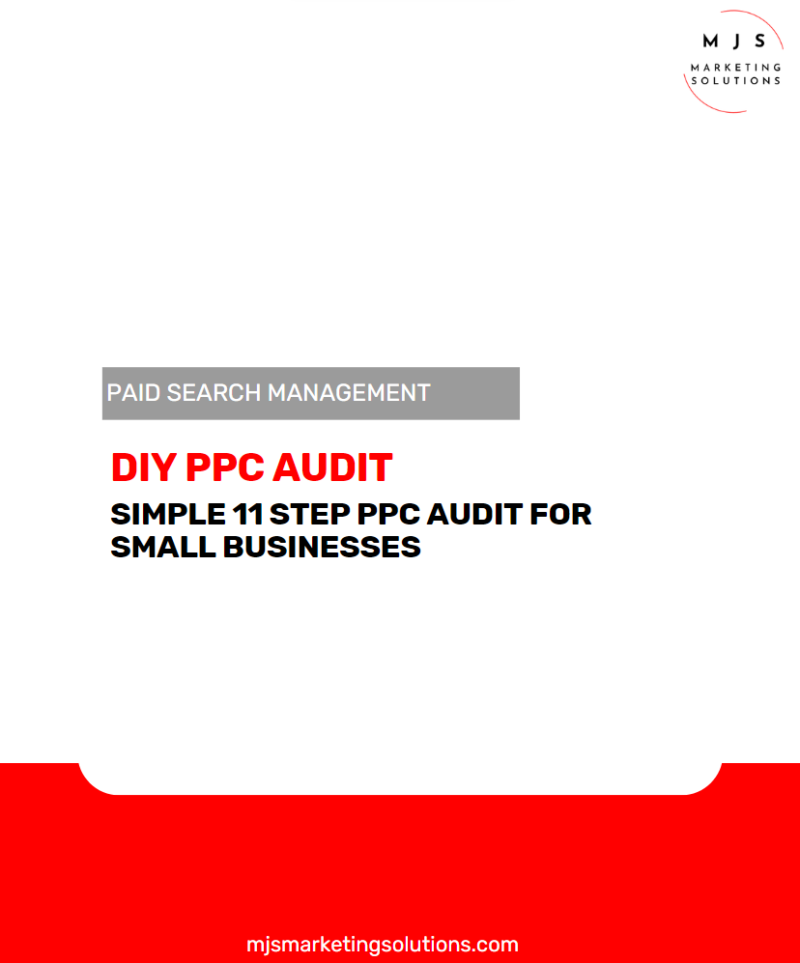Paid search is a game changer for pest control companies looking to expand their reach and attract new clients. Unlike traditional marketing methods, pay-per-click advertising (PPC) allows you to connect directly with potential customers actively searching for pest control solutions.
With advertising platforms like Google Ads, you can create targeted campaigns that deliver your message to the right audience at the right time. This means you only pay when someone clicks on your ad, making it a cost-effective strategy for generating leads.
However, to truly harness the power of paid search, it’s essential to understand how to set up your campaigns effectively, manage your budget wisely, and continuously analyze your performance. This guide will walk you through the process of launching successful pest control Google Ads campaigns tailored to the pest control industry, ensuring you maximize your return on investment and grow your business.
Types of Google Ads Campaigns For Pest Control
A well-structured Google Ads campaign is essential for maximizing effectiveness. However, before getting into the details of setting up a campaign, it’s important to consider the various campaign types and how they all work. Below are the main campaign types that would be best for a pest control business to utilize based on both effectiveness, ROI, and branding and awareness.
Search
Search Ads are the classic type of targeting used to generate leads based on specific service you offer that your potential customers are looking for. With search ads, you place bids on various keywords based on what your target market and services and compete with other pest control businesses for clicks. Simple? Yes, on the surface. At a deeper level, there are lots of intricacies involved with running an EFFECTIVE search campaign the nets you both: quality leads and revenue growth.
Search ads are the go to for pest control businesses due to the intent of the targeting and ability to help you drum up new business quickly.

Image source: Google – Search Ads
Local Service Ads
Google Local Service Ads are a great option for pest control businesses as it is a more performance driven option compared to traditional search ads. With Local Service Ads, you would pay when potential customers, not clicks, allowing you to focus on results!
Local Service Ads are offered for 35+ types of home service types, including pest control.
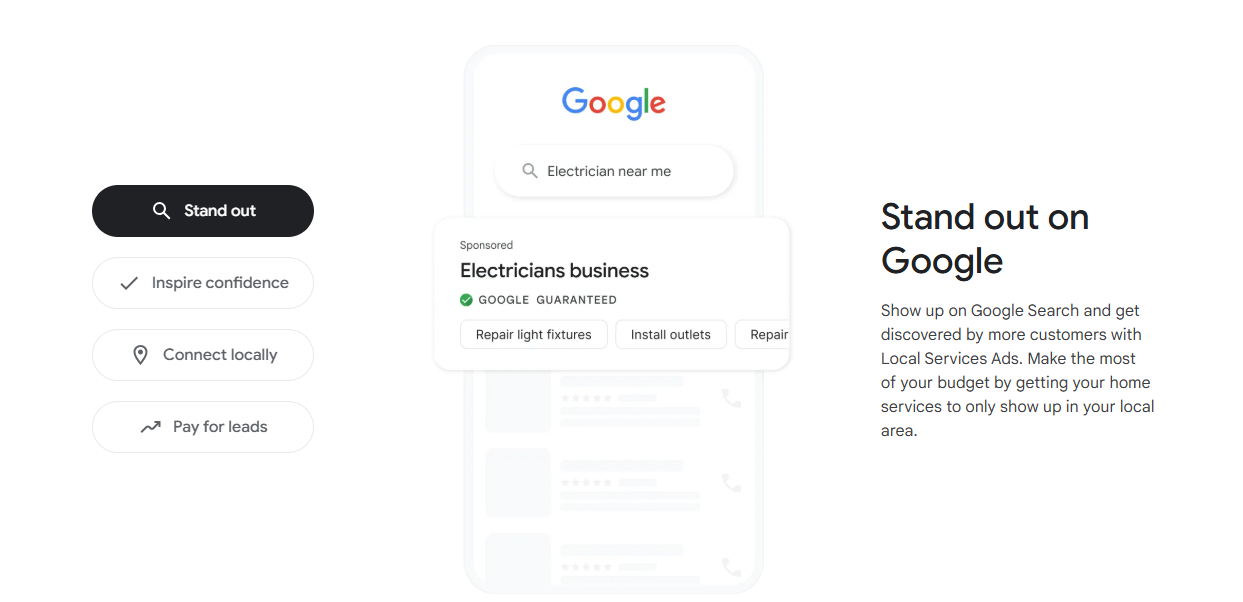
Image source: Google – Local Service Ads
Display
Display ad campaigns are a great way to promote your pest control business at a low cost compared to other campaign types. Unlike Search and Local Service ads, Display ads are shown across a number of different platforms and rely solely on audience targeting rather than real-time search. For example, there are 2 main broad types of audiences that can be targeted with display:
Prospects: Those who may be in the market for services you offer and have not interacted with your business before
Remarketing: Those who have engaged with your website previously.
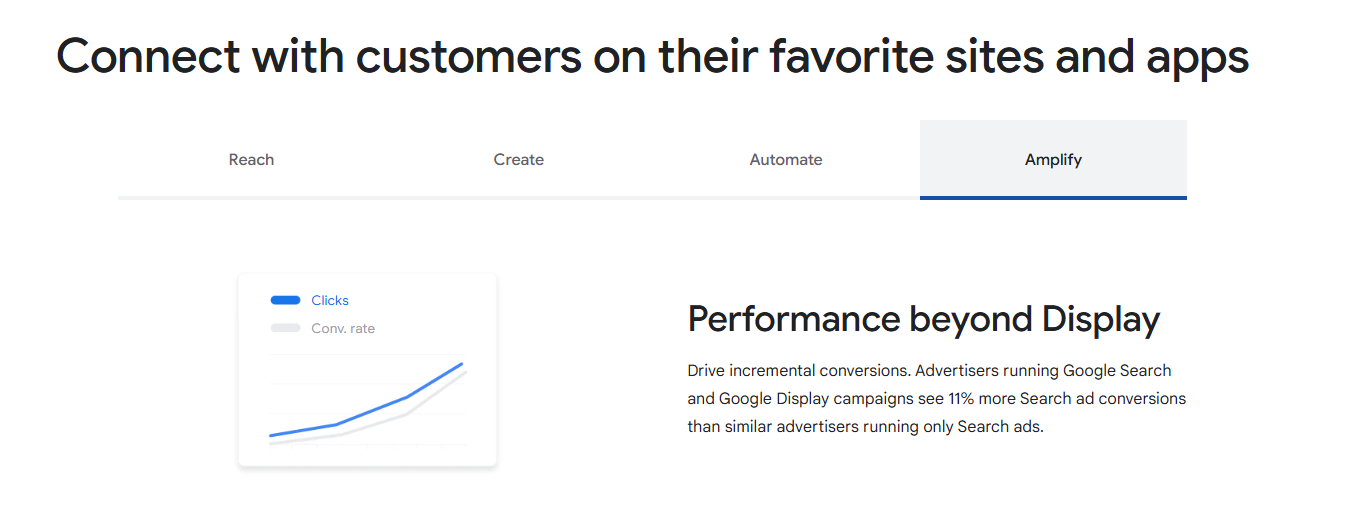
Image source: Google – Display Ads
Video / YouTube
Video or in most cases, YouTube ads, are a great way to create awareness for your pest control business. By nature, video ads are a key touch point in the buying cycle. While video ads do not directly generate a high ROI for service based businesses, they are a great influencer in keeping your brand top of mind when the need for your services arises.
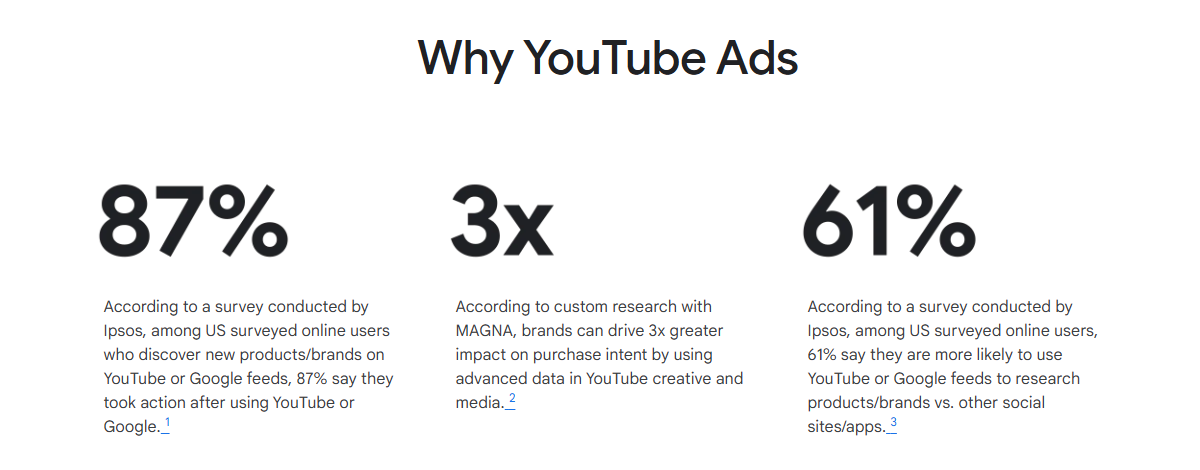
Image source: Google – YouTube Ads
Demand Gen
Compared to other campaign types, Google Demand Gen (formerly Discovery) is an under utilized campaign type. Demand Gen campaigns are very versatile in how they work and are targeted towards your customers. For example, you can target your main audience in unique ways across various platforms with multiple ad types. For pest control businesses, Google Demand Gen is a great tool for branding, lead generation, and more.
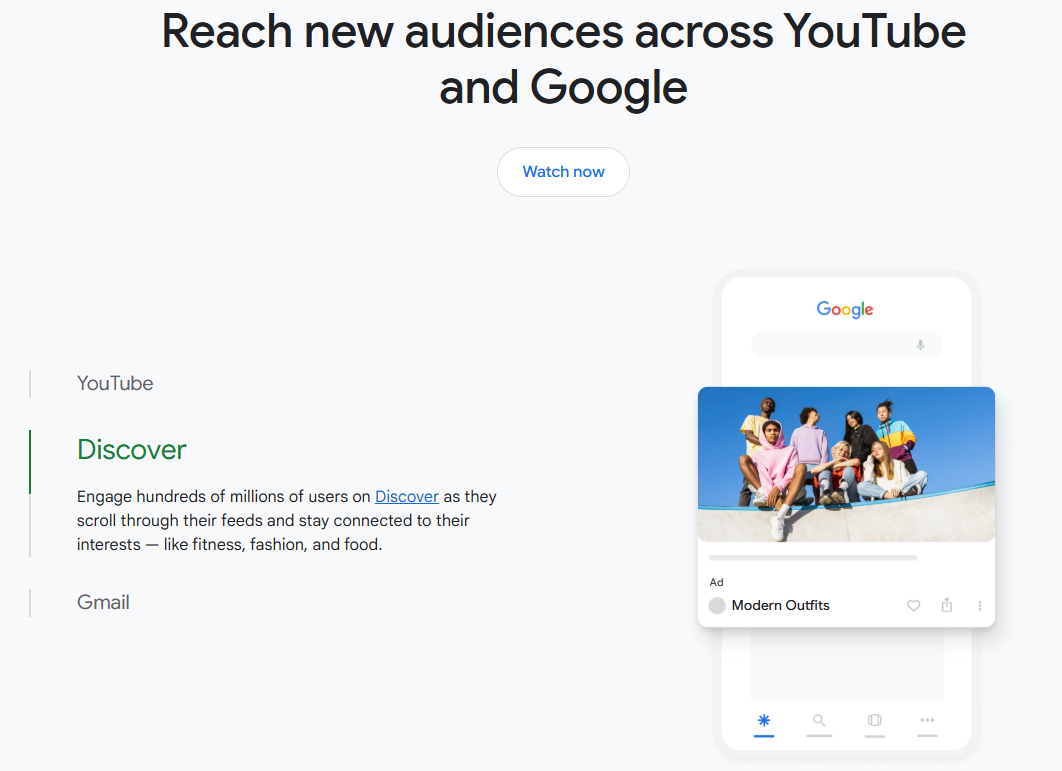
Image source: Google – Demand Gen Ads
Not sure where to start with google ads for your pest control business?
Looking to scale your current Google Ads campaigns?
Need more Pest Control Service Leads?
Setting Up Your Google Ads Campaigns
A well-structured pest control Google Ads campaign is essential for maximizing effectiveness not only with driving leads and generating more revenue, but with management if you’re going to run the ads yourself.
Campaign Structure
Begin with broad campaigns focusing on primary services like “pest control services,” “bed bug removal,” or “termite treatment.” As data accumulates, refine these into more targeted campaigns and ad groups.
Organizing ad groups by specific themes (e.g., “ant control”) ensures that ads and landing pages are highly relevant to search queries.
Below is an example of an ads account and campaign structure. The goal is to make it as organized and simple as possible to ensure the easiest management to and avoid cannibalization and confusion within the campaign(s).
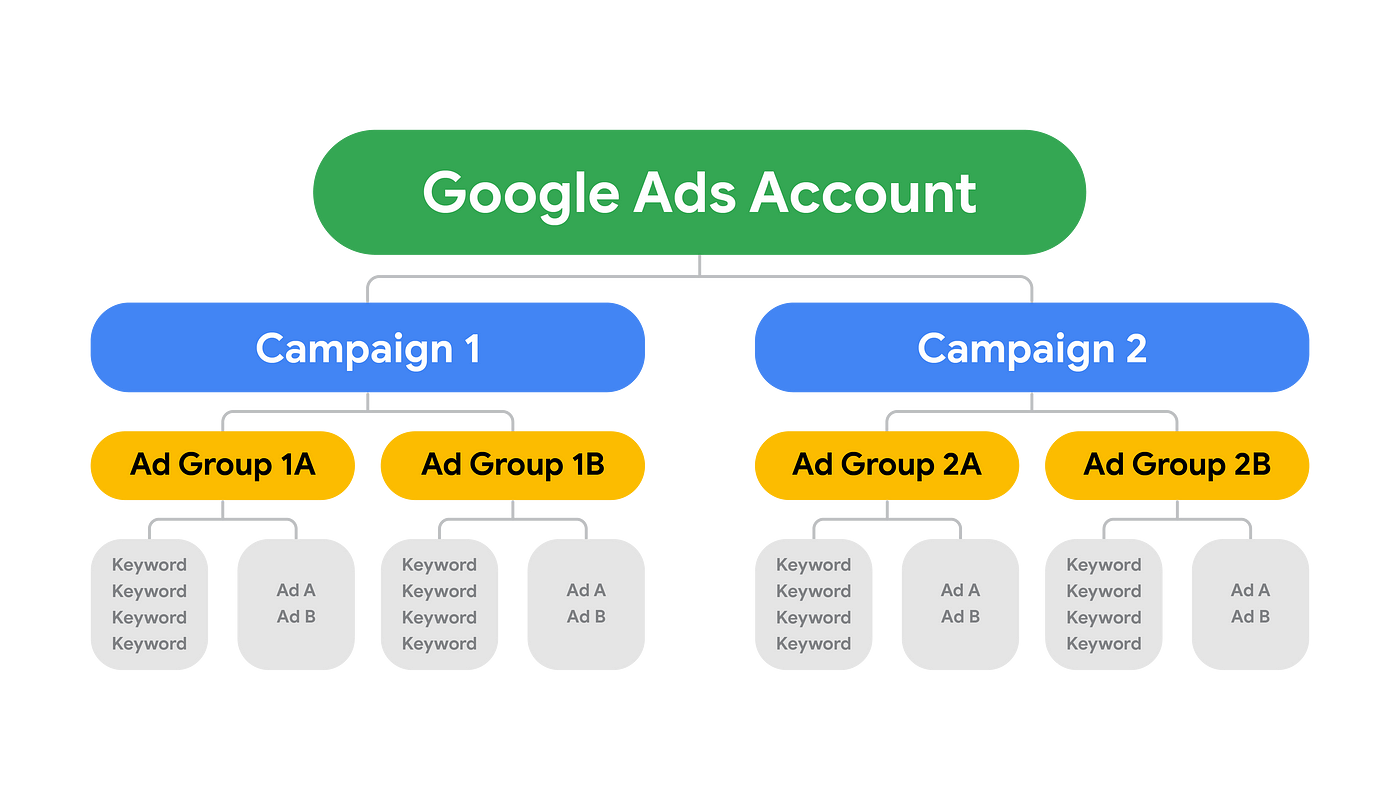
Ad Targeting and Settings
Configure geographic targeting to focus on your service areas, ensuring that only users in relevant locations see your ads. Device targeting is also crucial; given the high volume of mobile searches, ensure your ads are optimized for mobile devices. Implement ad extensions to provide additional information, such as your business address, phone number, and direct links to specific service pages, making your ads more informative and appealing.
Keyword Research & Strategy
Keyword research is the foundation of any successful pest control paid search campaigns. Choosing the right keywords ensures your pest control ads will be seen by the people most likely to click.
An easy way to get started with your initial keyword research is by identifying common pest issues in your service area and select keywords that potential customers are likely to use.
Consider the intent behind searches; for instance, someone searching for “termite inspection” is probably looking to hire a professional.
Incorporate long-tail keywords, which are more specific and less competitive, such as “pest control in [Your City].” Emphasizing local keywords enhances visibility among nearby customers.
When conducting keyword research for pest control, keep the following in mind:
- Understanding your target audience is crucial.
- Identify the specific pests your customers are concerned about and tailor your keywords accordingly.
- Utilize tools such:
- Google Ads Keyword Planner (Free)
- Google Search Console (Free – need to set up for your website)
- SEM Rush (Paid)
- Ahrefs (Paid)
- Keywords Everywhere (Paid)
- & more to discover search volume and competition levels for your chosen keywords.
- Long-tail keywords can be particularly effective as they often indicate a higher intent to purchase.
- Regularly review and adjust your keyword strategy based on performance metrics to stay ahead of the competition.
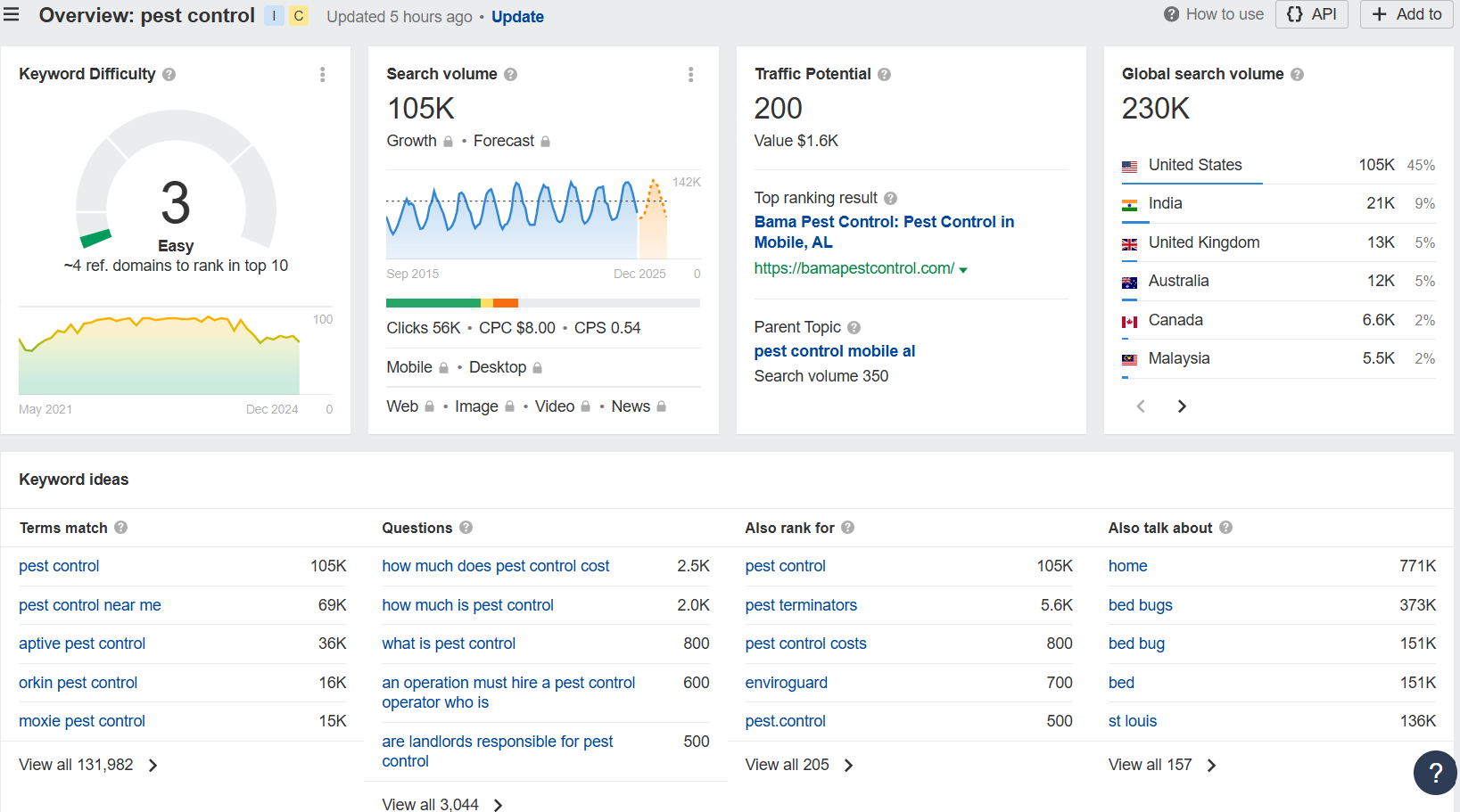
When developing a pest control keyword strategy, it’s important to consider not only the above items, but the potential traffic, the costs associated with it, the competition, but also the scale you’re willing to invest in to generate leads and grow.
Based on Ahrefs data of the head term “pest control software”, there are over 132,000 unique keywords branching off of the root term ranging from education, DIY, b2b non service, branded terms, and more. This makes it difficult to possibly target what you want for your campaign if you do not know what you’re looking for based on the intent.
Learn more about pest control keywords and targeting in this pest control keywords guide where I offer the top 100 keywords to help you understand what is being searched by your potential customers!
Negative Keywords
Negative keywords are a critical part of your search campaign strategy, and may be even more important than your target keywords. Negative keywords allow you to exclude various search terms from your campaigns and help you focus on only the keywords that get you in front of prospective customers and generate leads.
With the help of a detailed negative keywords strategy, you will not only show your ads to the right people, but you will significantly reduce wasted spend in your campaign(s), thus increasing effectiveness and ROI
Location Targeting and Ad Scheduling
To maximize the performance of your Google Ads campaigns, effective location targeting and ad scheduling (dayparting) are essential. These strategies ensure your ads reach the right audience in the right place and at the right time, helping you drive higher-quality leads while optimizing your ad spend.

Location Targeting: Reach the Right Customers
Identify Your Service Areas:
Focus on cities, neighborhoods, or ZIP codes you actively serve. Use customer data or insights to identify high-demand areas (e.g., neighborhoods with known pest issues).
Set Up Geographic Targeting in Google Ads:
Navigate to the “Locations” section in your campaign settings.
Choose from the following options:
Target a Radius: Specify a radius around your business location, such as “15 miles from [City Name].”
Target Specific Areas: Enter individual cities or ZIP codes to focus on.
Exclude Irrelevant Locations: Remove areas where you do not offer services.
Use Advanced Location Options
People in or regularly in your targeted location: Ensures you target individuals physically located within your service areas.
Exclude people searching for or showing interest in excluded locations: Prevents clicks from users outside your geographic focus.
Incorporate Location-Based Keywords
Combine location keywords with service keywords in your campaigns to improve relevancy.
Example: “Bed Bug Removal in Austin” or “Rodent Control near Miami.”
Tips for Effective Location Targeting
- Monitor Location Performance: Use Google Ads reporting to identify which areas generate the most clicks and conversions.
- Refine Over Time: If some areas underperform, remove them or reduce bids to focus on high-converting locations.
- Target Seasonal Hotspots: Adjust targeting to focus on neighborhoods with seasonal pest issues (e.g., mosquitoes in summer, rodents in winter).
Ad Scheduling: Timing Your Ads for Maximum Impact
Ad scheduling, or dayparting, allows you to control when your ads run. This ensures your campaigns are active during times when potential customers are most likely to engage.
Key Benefits of Ad Scheduling
- Increase ROI: Focus your budget on high-conversion time periods.
- Improve Lead Quality: Reach users during business hours or known peak times.
- Reduce Wasted Spend: Avoid running ads when your business is closed or leads cannot be serviced promptly.
Steps to Set Up Ad Scheduling
Analyze Historical Performance: Use Google Ads or Analytics to review when your ads receive the most clicks, calls, and conversions. Identify trends such as higher engagement during weekday mornings or late afternoons.
Define Your Business Hours: Focus on times when you can respond quickly to inquiries. For example, if your business hours are 8 AM–6 PM, avoid running ads overnight unless you have 24/7 service.
Set Up Ad Scheduling in Google Ads:
-
- Navigate to the “Ad Schedule” section under campaign settings.
- Specify days of the week and time blocks when your ads should run.
- Example:
-
- Monday–Friday: 8 AM–6 PM (business hours).
- Saturday: 9 AM–2 PM (shortened weekend hours).
- Sunday: Turn off ads unless offering emergency services.
-
Bid Adjustments for Time Periods
Use bid adjustments to increase or decrease bids based on performance trends. Example: Increase bids by 20% during peak hours (e.g., 8–10 AM) when conversions are highest, and lower bids during slow hours.
Examples of Ad Scheduling Scenarios
Scenario 1: Normal Business Hours
If your team can only respond to inquiries during regular business hours, run ads from 8 AM–6 PM and pause them after hours.
Scenario 2: Emergency Pest Control
For 24/7 services, keep ads running but allocate a higher budget to peak times like mornings and early evenings when people are most likely to call.
Combining Location Targeting and Dayparting
When used together, location targeting and ad scheduling create a powerful strategy to maximize campaign efficiency.
Best Practices
Localize Scheduling by Region:
If you serve multiple cities, adjust ad schedules based on time zones or customer behaviors in different areas. Example: Run ads earlier in rural areas where homeowners may address issues before commuting.
Focus on High-Value Time Blocks:
Use data to determine peak hours in specific locations. For example, urban areas may see higher engagement during lunch breaks (12–1 PM), while suburban areas may peak in the evening (5–7 PM).
Track and Optimize:
Regularly monitor performance data for location and scheduling. Adjust settings to focus on the most profitable areas and times
Common Mistakes to Avoid
- Running Ads 24/7 Without Strategy:
If your business cannot respond to leads after hours, running ads overnight can waste budget. - Targeting Too Broadly:
Casting a wide net geographically may result in low-quality leads or clicks from areas you don’t service. - Ignoring Data Trends:
Not using historical performance data to refine scheduling or targeting can lead to missed opportunities for optimization.
By leveraging precise location targeting and strategic ad scheduling, pest control businesses can ensure their Google Ads campaigns reach the right audience at the right time.
These tactics help optimize budgets, improve lead quality, and increase conversions. Regularly review and refine your campaigns based on performance data to maintain a competitive edge.
Effective Ad Copy for Pest Control Campaigns
Ad copy is the cornerstone of a successful Google Ads campaign. For pest control businesses, your ads must grab attention, convey trust, and compel potential customers to take immediate action.
Effective ad copy for pest control campaigns is about connecting with your audience’s needs while showcasing your expertise and value. By crafting specific, solution-oriented ads with strong CTAs and utilizing extensions, you can increase clicks and conversions while building trust with potential customers. Regularly test and refine your ads to ensure they resonate with your audience and deliver results.
Understand Your Audience
Your potential customers are often stressed or in urgent need of help. Tailor your messaging to address their specific concerns:
- Common Pain Points: Infestations, damage to property, health risks, or embarrassment.
- Desired Outcomes: Quick relief, guaranteed results, and safe treatments.
Example Insight:
A homeowner with termites might search for “termite exterminator near me” hoping for an affordable, reliable, and fast solution.
Elements High Converting Ad Copy
Headlines
Your headline is the first thing users see. It must be eye-catching, relevant, and action-oriented. Google allows up to 30 characters per headline, so every word counts.
- Headline 1: Directly address the service or problem. Example: “Fast Termite Control Today!”
- Headline 2: Highlight a unique selling point (USP) or value. Example: “Family-Safe, Guaranteed Results.”
- Headline 3: Add urgency or a call to action. Example: “Schedule Your Free Inspection.”
Descriptions
Descriptions offer more detail and reinforce your value. With a 90-character limit, focus on benefits and calls to action.
- Mention guarantees or assurances. Example: “Effective pest control with a 100% satisfaction guarantee.
- Highlight specific offers. Example: “Get $50 off your first treatment today.”
- Add urgency or limited-time deals. Example: “Call now! Offer ends soon.”
Writing Techniques for Compelling Copy
Be Specific and Solution-Oriented
Speak directly to the problem you’re solving:
- Bad: “We do pest control.”
- Good: “Eliminate pests quickly with our 24/7 pest control experts.”
Highlight Trust and Authority
Customers want reliable professionals:
- Include certifications or guarantees. Example: “Licensed, insured, and locally trusted since 2005.”
- Showcase social proof, such as reviews or ratings. Example: “Rated #1 Pest Control in [City].”
Use Actionable Language
Guide users to take the next step with clear calls to action (CTAs):
- “Call now for a free quote!”
- “Book your inspection today!”
Incorporate Keywords
Include high-intent keywords naturally in your copy to align with user searches:
- “Ant Exterminator Near Me”
- “Affordable Bed Bug Treatments”
Enhancing Ads with Extensions
Ad extensions provide additional information and improve visibility. They can make your ad copy even more compelling by adding value:
- Call Extensions: Add a clickable phone number for easy contact. Example: “(555) 123-4567 – Call Us Now!”
- Sitelink Extensions: Direct users to specific service pages. Example: “Rodent Control | Termite Treatment | Free Inspection.”
- Location Extensions: Highlight your local presence and build trust. Example: “Serving [City Name] and Surrounding Areas.”
- Callout Extensions: Highlight key benefits like “Eco-Friendly Solutions” or “Emergency Services.”
What to Avoid
- Vague Messaging: Avoid generic phrases like “Great service” or “Pest control pros.” Instead, focus on specifics.
- Ignoring Mobile Users: Optimize your ads for mobile, ensuring CTAs like “Call Now” are prominent.
- Overstuffing Keywords: Ensure your copy is readable and natural, not keyword-heavy.
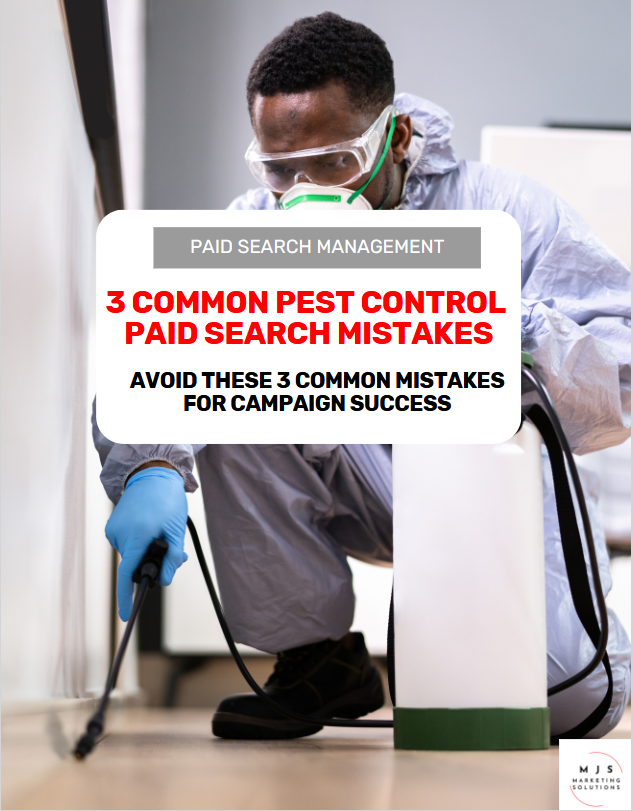
Make your pest control paid search campaigns run as effective as possible by knowing and avoiding these 3 common mistakes. This easy to follow guides provides insights into common areas that impact performance and suggests areas of opportunity for you to continue generating leads and closing more sales from your paid search campaigns.
This guide will cover areas such as:
- Budgeting
- Audiences
- Location Targeting
- ROI Analysis
- and more
Budgeting
Managing your Google Ads budget is crucial for the success of your advertising efforts as it determines the financial resources allocated to your campaigns.
A well-structured budget allows you to control your spending while maximizing your reach and effectiveness. Your bidding strategy plays a pivotal role in this process, guiding Google Ads on how much you’re willing to invest for each click.
By regularly reviewing and adjusting your budget, you can respond to performance trends and market changes, ensuring that your campaigns remain competitive. Embrace the art of budget management to unlock the full potential of your Google Ads initiatives.
Setting A Budget For Your Pest Control Campaigns
Things to consider:
- Goals: What is your goal for this campaign? Are you looking to increase awareness for your brand, generate leads and sales, or simply engage with potential customers before they buy in other ways.
- Competition: What does your local market look like in regards to your competitors spending money and bidding on similar services and keywords? How aggressive do you want to be in bidding for the top spots in your target keyword auctions? Competition is a large piece of the budget puzzle that can make a major impact on your plans and forecasts.
- Expected ROI: The way to look at Google Ads is like investing in a tool, because it is one, rather than a money pit, which many seem to do way too often due to poor management and inexperience. When determining budgets, it’s best to forecast ROI and what you foresee your campaigns returning in revenue to make Google Ads a viable, and really, useful tool for your business.
Budget Tips & Recommendations
It is highly recommended to set a conservative yet realistic budget for your Google Ads campaign. It’s not uncommon for businesses running pest control Google Ads campaigns for first time to be way too nervous at losing money, so they dedicate an amount like $20 a day into their campaign and want to target any and all pest control service in a competitive market.
Almost every time, without fail, these very low budget campaigns are very poor performing and leave a bad taste in the pest control business owner’s mouth. It’s not uncommon to hear something along the lines of “Google Ads doesn’t work, it’s a waste of money, we tried it and got no leads, the last person / agency / etc. didn’t know what they were doing”.
By a show of hands, who’s heard or said this before???? Kidding…kind of.
Budget Issue: Not Giving Campaigns Enough budget
When not giving your campaigns enough money to work not only creates an underperforming account or campaign, it ends up wasting more money than a better funded one. Reason being, Google Ads needs adequate finding to work as intended. Yes, there may be situations where it seems like you’re burning money initially, but you’re buying data. It’s up to you to understand that this initial slow period is necessary.
With all that being said, it’s a good idea to start with a number that’s easy to manage yet realistic, such as $100 per day, then scale up as you see results.
Again, Google Ads needs to be viewed as an investment, because it is one of the best ones you can make for growing your pest control business. With that investment there is risk (ad spend vs ROI), but this risk will be minimized over time with the right budget and strategies.
Tips for managing your Google Ads budget include:
-
Start small: Use tools such as Google Keyword Planner tool to estimate the cost of targeting the keywords you want. Find your minimal effective spend, then increase as you track results and optimize your ads.
-
Control your spend: Use bidding strategies such as target CPA to keep ad spend under control.
-
Test, measure, test again: Try new keywords and groups. Mix up your ad extensions. Experiment with different bidding strategies.
As you can see, successful budgeting in Google Ads balances data-informed decision-making with data-informed creative risk.
Bidding Strategies
Your Google Ads CPC bidding strategy tells Google how much you’re willing to pay for each individual click on an ad. There are several different CPC bidding strategies available. The best one for your pest control business will depend on your goals and budget.
Some of the most common cost-per-click bidding strategies include:
-
Manual CPC: Manual CPC gives you the most control over your spending. It lets you specify the maximum amount you’re willing to pay for each click. The downside: Manual CPC is the most time-consuming bidding strategy to manage.
-
Enhanced CPC: Enhanced CPC, or ECPC, maximizes conversions at your target cost per acquisition (CPA). It does so by automatically adjusting your bids with the help of a machine-learning algorithm. That makes ECPC a good option for those who don’t want to manage bids manually.
-
Target CPA: Also powered by a machine learning algorithm, target CPA automatically sets your bids to get as many conversions as possible at your target CPA. That makes it a good option if you have a specific CPA in mind and want to maximize conversions at that cost.
Those new to Google Ads benefit the most from starting with manual CPC. That way, you learn firsthand how the bidding system works. Once you better understand how bidding works, you can experiment with ECPC, target CPA, and other bid strategies.
DIY vs Professional Campaign Management
Managing Google Ads for pest control services requires significant expertise and time. While a DIY approach may seem cost-effective, it often leads to wasted ad spend and suboptimal results. Professional management offers immediate optimization, advanced strategies, and quicker returns on investment.
DIY
Managing Google Ads for a pest control business on your own might seem like a cost-effective approach at first, but it comes with significant hurdles that can impact results:
- Learning Curve:
Mastering Google Ads is no small feat. Beginners often require 3-6 months just to learn the platform’s basic functionality, including campaign setup, bidding strategies, and ad extensions. Advanced techniques like retargeting, audience segmentation, and using negative keywords can take even longer to understand and apply effectively.
- Time Investment:
DIY management demands substantial time, especially in the early stages. Expect to spend 10-15 hours per week monitoring campaigns, analyzing performance metrics, and making adjustments. For a pest control business owner with other responsibilities, this level of time commitment can be difficult to sustain.
- Risk Level:
Without prior expertise, it’s easy to waste significant ad spend. Common mistakes include targeting overly broad keywords, neglecting to use negative keywords, and failing to optimize for mobile users. These errors can result in wasted budgets—often between $1,000-$3,000 within the first few months—without generating meaningful leads.
- Performance Limitations:
DIY campaigns are typically limited by the advertiser’s knowledge and ability to stay updated with platform changes. Without advanced techniques like A/B testing, dynamic ad creation, and remarketing, performance may plateau at a basic level.
- ROI Timeline:
It can take 4-6 months to see consistent results with a DIY approach, as trial-and-error adjustments are necessary to optimize campaigns. This extended timeframe may delay profitability and growth.
Professional Management
Partnering with a professional Google Ads manager or agency offers distinct advantages that can lead to faster and more effective results for pest control businesses:
- Immediate Expertise:
Professionals hit the ground running, bringing years of experience and knowledge of advanced strategies. They know how to structure campaigns, optimize bidding, and refine targeting from the start, eliminating the guesswork.
- Minimal Time Commitment:
With experts handling the heavy lifting, pest control business owners can focus on running their operations. Professional management typically requires only 1-2 hours of oversight per week for review meetings or approvals.
- Risk Mitigation:
Professionals know how to avoid common pitfalls like irrelevant clicks and wasted spend. They implement negative keywords, refine geographic targeting, and optimize ad placements to ensure your budget is used efficiently.
- Advanced Optimization:
Agencies bring tools and expertise that DIY users rarely have access to. Techniques like multi-channel retargeting, dynamic keyword insertion, and advanced audience segmentation can significantly boost ad performance.
- Faster ROI Timeline:
Professionals often achieve noticeable results within 1-3 months. Their ability to optimize quickly means your campaigns can generate leads and revenue much sooner.
- Scalable Campaigns:
A professional can design campaigns that grow with your business, from adding seasonal ad variations to launching new campaigns tailored to different pest types or geographic areas.
ROI Considerations
While managing Google Ads on your own can work for businesses with time and a willingness to learn, it comes with significant risks and challenges.
For most pest control businesses, professional management delivers a better return on investment by leveraging expertise, saving time, and producing faster results.
Given the competitive nature of the pest control industry, having a pro on your side could mean the difference between an average campaign and one that consistently drives quality leads resulting in greater revenues and profit margins from your campaigns.

